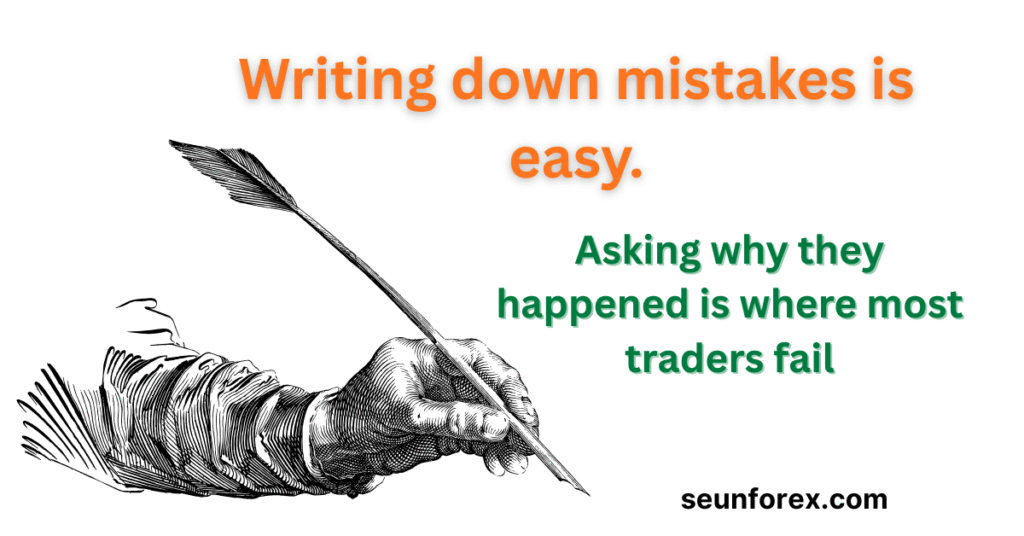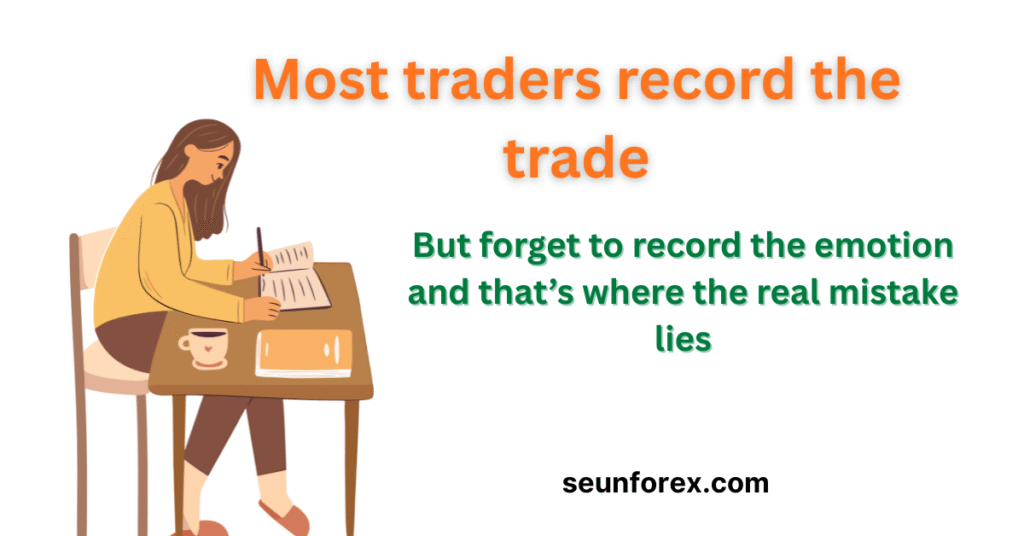
“The most important thing in trading is to keep your emotions in check.” — Dr. Van Tharp
Every trader has heard the same advice: “Keep a trading journal.” The logic seems unshakable: write down your trades, reflect on your actions, identify mistakes, and surely you’ll get better.
And in many ways, it’s true. Journaling in trading is one of the most powerful self-reflection tools in a trader’s arsenal. It captures your decisions in black and white, shines a light on repeated patterns, and gives you a historical record of progress.
But here’s the frustrating truth:
Even the most disciplined journaling in trading habits don’t automatically stop traders from repeating the same costly mistakes.
You’ve probably lived this cycle yourself:
- You overtrade, break your rules, or move your stop.
- You lose money.
- You promise yourself: Never again.
- That evening, you carefully journal the mistake.
- A week later, under pressure or temptation, you repeat it.
It’s maddening. You’re writing. You’re reflecting. You’re doing what the experts say. Yet the same patterns resurface.
So, what’s going on?
The answer is simple but uncomfortable: Journaling is not a cure. It’s a tool. And like any tool, its effectiveness depends on how you use it. Too often, traders confuse documentation with transformation. They write their mistakes down but fail to address the deeper emotional and psychological traps that drive those mistakes in the first place.
This essay explores why journaling alone doesn’t break destructive cycles, what’s really happening in your brain when you repeat mistakes, and how to transform your journaling process into a growth system that truly reshapes your trading behavior.
I. The Illusion of Progress in Trading Journaling

One of the biggest traps in trading is mistaking activity for progress. Journaling, when done at a surface level, feeds this illusion.
You finish a trading day. You log into your spreadsheet. You jot down:
- “EUR/USD long. Entered too early. Got stopped out. Lesson: wait for confirmation.”
You close the laptop with a sense of accomplishment. At least I wrote it down.
But what really changed? Nothing.
This is the illusion of progress. Writing about mistakes feels productive, but unless you dig into the root causes and create actionable change, journaling is nothing more than glorified record-keeping.
Why does this illusion persist?
- Emotional Relief: Writing mistakes gives temporary catharsis. It feels like you’ve “handled it,” even though nothing has changed.
- Cognitive Bias: Our brains are wired to overvalue awareness. We think, Because I noticed it, I won’t do it again. But recognition without action is useless.
- False Security: Having a stack of journals makes us feel disciplined. But a shelf of notebooks doesn’t equal better results.
Progress in trading doesn’t come from documenting problems. It comes from changing behavior under pressure. And that requires more than words on a page.
II. Common Mistakes Traders Make with Trading

Journals
Let’s look at why journaling often falls short.
1. Surface-Level Reflection
Most traders stop at “what happened” instead of “why it happened.” For example:
- “I overtraded.”
- “I didn’t follow my stop-loss rule.”
But why? Was it boredom? Was it overconfidence? Was it fear of missing out (FOMO)? Without drilling into root causes, the journal stays shallow.
2. No Emotional Tracking
Trades aren’t just technical decisions — they’re emotional events. Yet most journals don’t capture feelings. Traders log prices and setups but ignore emotions like:
- Anxiety before entry.
- Fear when price moved against them.
- Greed that tempted them to double down.
Without emotional tracking, you miss the very drivers of repeated mistakes.
3. Lack of Accountability
Writing “I broke my rule” in a private notebook rarely changes anything. There’s no consequence, no feedback loop, no accountability. You’re both the judge and the guilty party — and your brain loves to let itself off the hook.
4. Treating Journaling as a Ritual
Some traders treat journaling like brushing their teeth. They do it out of habit, but without intention. They write because they’re “supposed to,” not because they’re actively seeking transformation.
5. No Integration with Data
Journals often lack hard metrics. A trader might write about mistakes but never track stats like:
- Win/loss ratio.
- Average risk/reward.
- Rule adherence percentage.
Without data, journaling becomes subjective storytelling.
III. The Psychology of Repetition in Trading Journaling
Why do traders repeat mistakes, even after journaling them?
The answer lies in how the brain learns and reacts under stress.
1. Habit Loops
Your brain runs on habit loops: cue → routine → reward. For example:
- Cue: Price spikes.
- Routine: Enter trade impulsively.
- Reward: The thrill of action.
Journaling identifies the mistake but doesn’t rewire the loop. Under pressure, the old habit wins.
2. Emotional Hijacking
When emotions run high, the amygdala (emotional brain) overrides the prefrontal cortex (rational brain). Fear, greed, or anger short-circuit logic. Journaling, done after the fact, can’t prevent this in-the-moment hijack.
3. Self-Justification
Humans are experts at rationalizing. After a loss, the brain whispers: This setup was different. It was worth the risk. Journaling can record the mistake, but if the brain believes the excuse, the cycle continues.
4. Dopamine and Reward Systems
Trading mistakes often bring hidden rewards: the thrill of risk, the relief of action, the ego boost of “being right.” These dopamine hits train the brain to repeat behaviors, even when they’re destructive.
IV. Why Journaling Alone Fails
Journaling fails to break cycles because it doesn’t automatically:
- Regulate emotions.
- Enforce accountability.
- Replace bad habits with new ones.
- Turn reflection into real-time discipline.
At best, journaling is a rearview mirror. It shows you what happened yesterday. But trading requires a steering wheel — tools that help you change behavior in the heat of the moment.
V. The Five Levels of Journaling Depth
Not all journaling is equal. Here’s a framework:
- Logging: Write trades and outcomes.
- Reflection: Note mistakes.
- Diagnosis: Explore emotional/psychological causes.
- Prescription: Write corrective steps.
- Integration: Update trading plan, track metrics, and enforce accountability.
Most traders never get beyond Level 2. True growth requires climbing to Levels 4 and 5.
VI. Case Studies
Case Study 1: John, the Revenge Trader
John journaled daily but kept revenge trading. His notes read: “I got frustrated and overtraded again.”
Breakthrough: He added a rule — after any loss, mandatory 15-minute break. His journal evolved from reflection to prescription. Revenge trades dropped by 70%.
Case Study 2: Maria, the Overleverager
Maria constantly over-risked. Journaling didn’t stop her.
Breakthrough: She added metrics — average risk per trade, % of rules followed. Tracking her “discipline score” shifted her motivation. Her average risk dropped from 3.5% to 1.2%.
Case Study 3: Alex, the FOMO Trader
Alex chased trades constantly. His journal was full of “entered too late.”
Breakthrough: He added pre-trade journaling: Before entering, he had to write, “Does this setup meet my 3 criteria?” This pause broke the FOMO loop.
VII. Transforming Your Trading Journal Into a Growth Tool

Here’s how to upgrade journaling:
- From Notes to Narratives
Write stories, not just entries. Explain context, emotions, and thought process. - Tagging and Categorizing
Use labels: overtrading, stop-loss violation, FOMO. Review tags weekly to spot trends. - Weekly Reviews
Don’t just write daily — review weekly. Ask:
- Which rules did I break most often?
- What emotion dominated?
- What will I test next week?
- Link to Data
Combine qualitative (feelings) with quantitative (metrics). - Feedback Loops
Turn journal insights into new trading rules and habits.
VIII. Beyond Journaling: Complementary Tools for Trading Discipline
Journaling is necessary but not sufficient. Pair it with:
- Accountability Partners: Share your journal with a mentor or peer.
- Mindfulness Training: Breathing exercises, meditation, grounding before trading.
- Checklists: Pre-trade and post-trade routines to enforce discipline.
- Emotional Conditioning: Reward discipline, not profits. Celebrate rule-following.
IX. The Final Takeaway
Journaling doesn’t stop trading mistakes. But transformed trading journaling can.
The mistake many traders make is treating a trading journal as an end. It’s not. It’s a starting point.
Here’s the shift every trader must make with journaling:
- From logging trades to diagnosing behavior.
- From writing mistakes to prescribing solutions.
- From private reflection to accountable action.
- From emotional chaos to structured trading discipline.
Your trading journal can either be a diary of repeated failures — or a blueprint for transformation. The choice depends on how you use it.
Next time you sit down to write in your journal, don’t just ask: “What happened?”
Ask: “How do I prevent this exact mistake from showing up again in my trading?”
For insights from one of the foremost experts on trading psychology and journaling, see Dr. Van K. Tharp on Trading Journals.
And if you’re ready to take journaling in trading further, go beyond notes and start building discipline through psychology-driven routines. I’ve broken this down in detail here: 👉 Trading Discipline & Psychology: 5 Steps to Success
That single shift separates traders who stay stuck from traders who finally grow.